Drumheller, Alberta 作者: 来源: 发布时间:2021-12-01
I.Population and Area
-Area (2016)
•Land: 108.03 km2 (41.71 sq mi)
-Population (2016)
•Total: 7,982
•Density: 73.9/km2 (191/sq mi)
-In the 2016 Census of Population conducted by Statistics Canada, the Town of Drumheller recorded a population of 7,982 living in 3,164 of its 3,471 total private dwellings, a -0.6% change from its 2011 population of 8,029. With a land area of 108.03 km2 (41.71 sq mi), it had a population density of 73.9/km2 (191.4/sq mi) in 2016.
-In the 2011 Census, the Town of Drumheller had a population of 8,029 living in 3,182 of its 3,418 total dwellings, a 1.2% change from its 2006 population of 7,932. With a land area of 107.93 km2 (41.67 sq mi), it had a population density of 74.4/km2 (192.7/sq mi) in 2011.
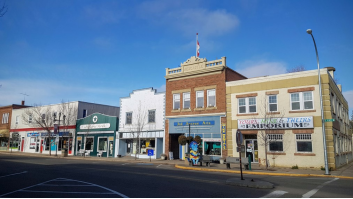
II.Natural Geography (environment and resources)
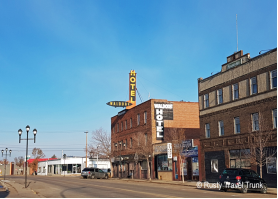
-Drumheller /drʌmˈhɛlər/ is a town within the Red Deer River valley in the badlands of east-central Alberta, Canada. It is located 110 kilometres (68 mi) northeast of Calgary, and 97 kilometres (60 mi) south of Stettler. The Drumheller portion of the Red Deer River valley, often referred to as Dinosaur Valley, has an approximate width of 2 kilometres (1.2 mi) and an approximate length of 28 kilometres (17 mi).
-Drumheller /drʌmˈhɛlər/ is a town within the Red Deer River valley in the badlands of east-central Alberta, Canada.
III.ECONOMY
-Average hourly earnings: C$22.14
-The average salary in Drumheller, null is C$22.14. Trends in wages decreased by -100.0 percent in Q1 2020. The cost of living in Drumheller, null is 100 percent higher than the national average. The most popular occupation in Drumheller, null is Production Supervisor which pays between C$14.35 and C$39.91 per year. The most popular employer in Drumheller, null is Alberta Health Services.
IV.Industrial Characteristics
-Today, coal mining has all but disappeared, replaced by natural gas and oil exploration and development. The town is the service centre for the primarily agriculturally based local economy. A federal penitentiary and a regional health complex also provide employment. Tourists are attracted to Drumheller by the striking landscape of the badlands along the Red Deer River, as well as the Fossil World Dinosaur Discovery Centre , the Homestead Antique Museum and the Royal Tyrrell Museum of Palaeontology.
-Today, agriculture is the biggest industry in the region followed closely by oil and gas production.
-These sectors employ hundreds of people in and around Drumheller.
-Tourism is the fastest growing industry in the town with thousands of people visiting the town each year to see the World’s Largest Dinosaur, Royal Tyrrell Museum, and Atlas Coal Mine just to name a few.
-Business Infrastructure
-The Department of Infrastructure Services is responsible for a wide range of tasks that ensure our public facilities are in peak working condition for your safety and use from the maintenance of equipment and facilities to snow clearing and special engineering projects.
-Website: https://www.dinosaurvalley.com/towndepartments
V.Attractions
1.Royal Tyrrell Museum of Palaeontology
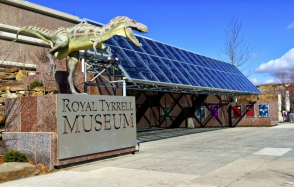
-The Royal Tyrrell Museum of Palaeontology (RTMP) is a palaeontology museum and research facility in Drumheller, Alberta, Canada. The museum is situated within a 12,500-square-metre-building (135,000 sq ft) designed by BCW Architects at Midland Provincial Park.
-Efforts to establish a palaeontology museum were announced by the provincial government in 1981, with the palaeontology program of the Provincial Museum of Alberta spun-off to help facilitate the creation of a palaeontology museum. After four years of preparation, the Tyrrell Museum of Palaeontology was opened in September 1985. The museum was later renamed the Royal Tyrrell Museum of Palaeontology in June 1990, following its bestowal of the title "royal" from Queen Elizabeth II. The museum's building was expanded twice in the 21st century. The first expansion was designed by BCW Architects, and was completed in 2003; while the second expansion was designed by Kasian Architecture, and was completed in 2019.
-The museum's personal collection includes over 160,000 cataloged fossils, consisting of over 350 holotypes. The museum displays approximately 800 fossils from its collection in its museum exhibits. In addition to exhibits, the museum's fossil collection are also used by the museum's research program, which carries a mandate to document and analyze geological and palaeontological history.
2.World's Largest Dinosaur
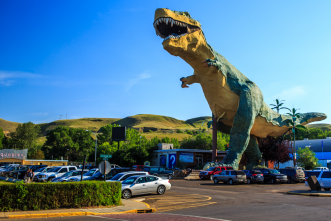
-The "World's Largest Dinosaur" is the name of a model Tyrannosaurus rex located in the town of Drumheller in the Canadian province of Alberta. Built of fiberglass and steel, it has a height of 26.3 metres (86 ft) and a length of 46 metres (151 ft), considerably larger than the largest known specimens of the actual dinosaur which reached up to 12.8 m (42 ft) in length, and up to 4 m (13 ft) tall at the hips.
-Drumheller is a town in the Badlands of east-central Alberta, on the Red Deer River, located 135 kilometres (84 mi) northeast of Calgary. Drumheller is home to the Royal Tyrrell Museum of Palaeontology. Various smaller dinosaur models are placed throughout the town. The dinosaur was built while former mayor Phil Bryant was in his term.
-The sculpture weights 145,000 lb (64.73 long tons; 72.50 short tons), 65,000 lb (29.02 long tons; 32.50 short tons) of which is steel. It has 106 stairs and the viewing area in the mouth is approximately 60 sq ft (5.6 m2) and can hold between 8 and 12 people at a time.
3.Horseshoe Canyon
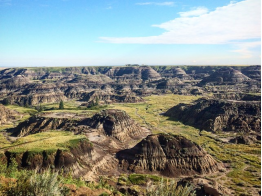
-Horseshoe Canyon is a region of badlands surrounded by prairie in the province of Alberta, Canada. It is located about 17 km west of Drumheller, Alberta, along Highway 9.
-The canyon gets its name from its horseshoe shape, defined by two coulees the flow into the Kneehill Creek, a tributary of the Red Deer River. The canyon's two arms are approximately 5 km long each, extending from Highway 9 to Kneehill Creek, at two former mining communities of Dunphy and Gatine. In turn, it gives the name to the Horseshoe Canyon Formation.
4.Atlas Coal Mine National Historic Site
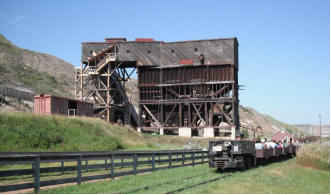
-The Atlas Coal Mine National Historic Site is an inactive coal mine in Alberta, Canada that operated from 1936 to 1979. Located in East Coulee, it is considered to be Canada's most complete historic coal mine and is home to the country's last standing wooden coal tipple, and the largest still standing in North America. It was designated an Alberta Provincial Historic Resource in 1989 and a National Historic Site of Canada in 2002.
VI.History
-The Town of Drumheller was named after Samuel Drumheller, who, after purchasing the homestead of Thomas Patrick Greentree, had it surveyed into the original Drumheller townsite and put lots on the market in 1911.
-Drumheller became a railway station in 1912. It then incorporated as a village on May 15, 1913, a town on March 2, 1916 and a city on April 3, 1930. Over a 15-year period, Drumheller's population increased 857% from 312 in 1916 to 2,987 in 1931 shortly after becoming a city.
-The City of Drumheller amalgamated with the Municipal District (MD) of Badlands No. 7 on January 1, 1998 to form the current Town of Drumheller. Some of the reasons the two municipalities amalgamated included the MD of Badlands No. 7 having more in common with Drumheller than other surrounding rural municipalities and both were experiencing similar planning and development issues due to their locations within the Red Deer River valley. The amalgamated municipality opted for town status rather than city status so that highways within would remain the responsibility of the Province of Alberta. As a result of the amalgamation, Drumheller became Alberta's largest town in terms of land area at 107.93 square kilometres (41.67 sq mi).
-The 1998 amalgamation resulted in Drumheller absorbing six hamlets that were previously under the jurisdiction of the MD of Badlands No. 7 – Cambria, East Coulee, Lehigh, Nacmine, Rosedale and Wayne. Drumheller also previously absorbed the hamlets of Bankview, Midlandvale (Midland), Newcastle and North Drumheller during annexations while under city status. Bankview and Midland were annexed in 1964 and 1972 respectively, while Newcastle and North Drumheller were both annexed in 1967. Other localities within Drumheller, either absorbed through past annexations or its eventual amalgamation with the MD of Badlands No. 7, include Aerial, Eladesor, Kneehill, Rosedale Station, Western Monarch (Atlas) and Willow Creek.
-In total, Drumheller has absorbed at least 13 other communities in its history, some of which are now recognized as neighbourhoods or districts within the town.
-From oil and gas to coal and dinosaurs, Drumheller’s long history is full of industrial entrepreneurs, pioneers, and innovators who brought with them a sense of optimism that remains with our people today.
-Drumheller is known as the dinosaur capital of the world because of the high concentration of fossils located in the area.
-Millions of years ago the Drumheller area was tropical which created a great environment for plant growth and where dinosaurs could flourish.
-After a cataclysmic event, these dinosaurs were wiped out leaving only their bones to be discovered millions of years later.
-In the 1880’s, J.B. Tyrrell came to present-day Drumheller looking for coal and found the skull of a dinosaur near the Red Deer River.
-That dinosaur became known as the Albertasaurus and so began the collection of dinosaur remains that are sought after by museums all over the world.
-The ice age formed what is now the Red Deer River Valley. As the glaciers melted and moved on they left behind lakes and large valleys.
-Approximately 11 thousand years ago new plants and animals started to emerge and First Nations Peoples began to roam the prairie learning and living from the land.
-Coal was eventually discovered as well.
-The Calgary-Drumheller railway was opened in 1913 bringing with it the many faces and families who would settle this new community with a profound sense of optimism and excitement.
-The first load of coal shipped out of the valley was from a Newcastle mine in 1911 by Jesse Gouge and Garnet Coyle who originally opened the mine.
-The Drumheller coal rush really heated up after Samuel Drumheller bought land in the valley from Thomas Greentree and sold it to the Canadian National Railway to develop a town site.
-A famous coin toss was made between Samuel Drumheller and Thomas Greentree to decide who would name the town.
-The coin fell in favor of Samuel Drumheller. Between 1911 and 1979, 139 mines were registered in the valley and over 56 million tons of coal was shipped across Canada.
-Coal mining was a dangerous job, claiming the life of many miners.
-The names of these miners are commemorated on a special memorial located beside Drumheller Town Hall at 224 Centre Street.
-The Atlas Coal Mine was the last one to close down in 1979 signaling the end of the coal mining era in the valley.
-This structure and the coal mining history have been preserved at the original Atlas Coal Mine site at East Coulee, attracting and educating hundreds of visitors each year.
VII.Other information
-This Town is one of the sunniest communities in all of Canada which is made even better by our friendly residents and vibrant social and cultural activities.
-Drumheller was founded in the early 1900’s as a major coal mining town and has since evolved into a large tourist centre, and agricultural hub.
-Drumheller has a large and modern health center that provides 24-hour emergency, acute care, continuing care, mental health, and public health services.
-Depending on the severity of a situation, the hospital can help prepare patients for STARS Air Ambulance helicopter trips.
-The Correctional Service of Canada (CSC) is also vital to the Drumheller economy. It employs nearly 500 people in this high tech medium and minimum security facility. -Their community boasts of an RCMP detachment with 16 officers serving both the rural and municipal areas.
-The Drumheller Fire Department has fire halls in Drumheller, Rosedale, and East Coulee.
-Drumheller boasts a wealth of museums and historic sites where traveller can relive history. As the Dinosaur Capital of the World, they like to live up to our reputation with rich abundance of dinosaur fossils and home of the world-renowned Royal Tyrrell Museum of Palaeontology.
VIII.Contact information
-Government
•Mayor: Heather Colberg
•Governing body: Drumheller Town Council
•CAO: Darryl Drohomerski
•MP: Damien Kurek (Battle River-Crowfoot)
•MLA: Nate Horner (Drumheller-Stettler)
-Address: 60 1st Ave W, Drumheller AB, T0J 0Y0
-Phone: 403-823-1331
-Toll Free: 1-866-823-8100
-Website: http://www.municipalaffairs.alberta.ca/mc_municipal_officials_search
